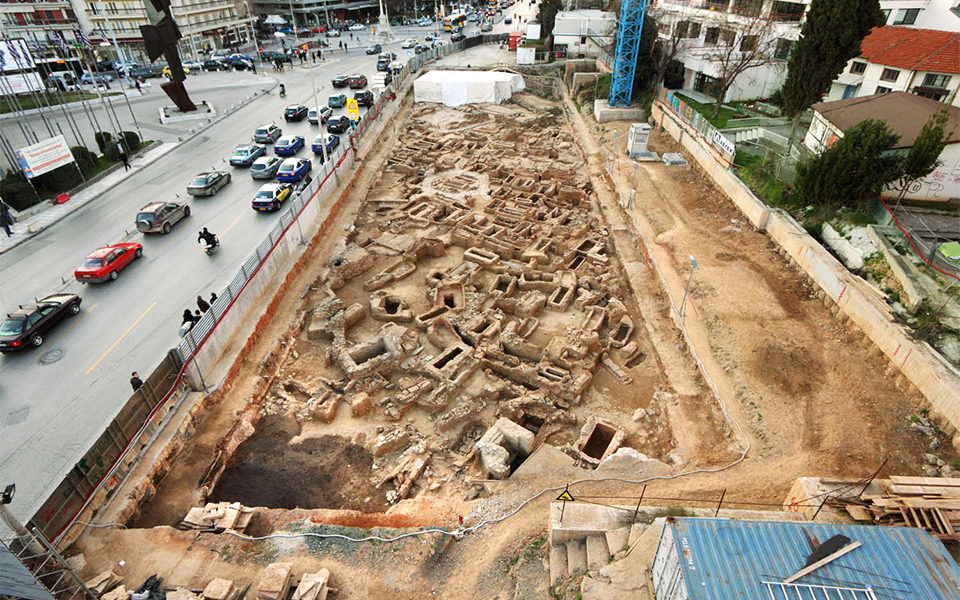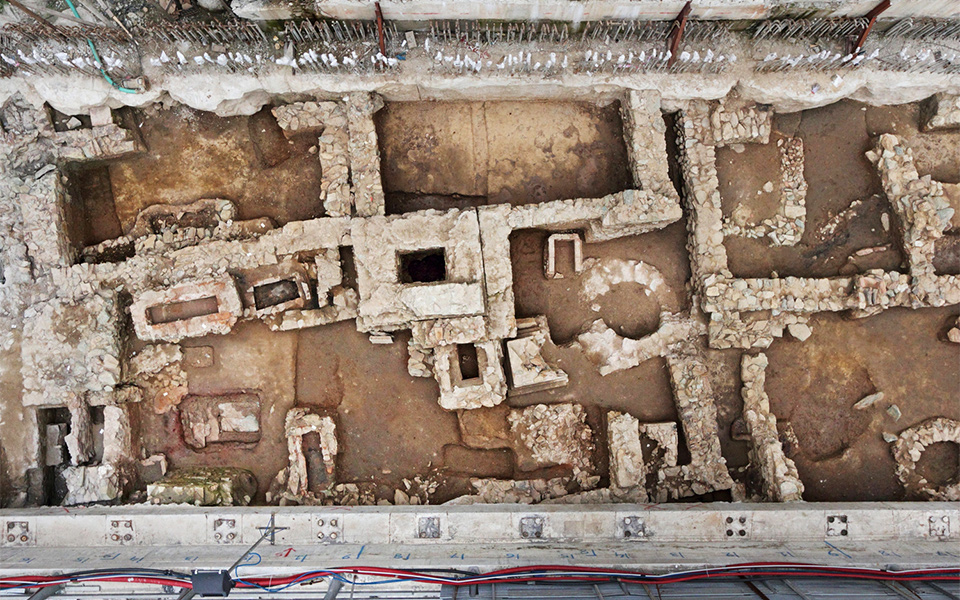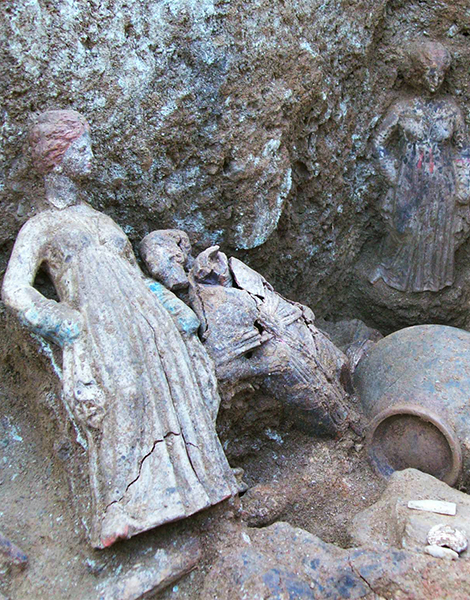In the Footsteps of St. Paul: A Pilgrimage...
Trace St. Paul the Apostle’s journey...

A gravesite uncovered near the site of the future subway station of Syntrivani.
We are walking on the ancient stone-paved avenue known to the Romans as the Decumanus Maximus, or main east-west road, six meters below the surface of what is today the Egnatia Odos, one of Thessaloniki’s central thoroughfares. This underground archaeological site, located in the heart of the city, resembles some kind of eerie netherworld.

An overhead view of the archaeological dig near the future subway station of Dimokratias.
“Every time I come down there, I am deeply moved,” says Polixeni Adam-Veleni, the deputy head of the Thessaloniki Ephorate of Antiquities. “I think of the words of the Byzantine expert Paolo Odorico: ‘Are you really going to destroy your Byzantine Pompeii?’ And he’s right. What reasonable person would even think of razing this road? How can you disturb something which has remained nearly undisturbed from the 6th century until today? To date, no one has dared touch it. Are we going to?”
Today, Adam-Veleni isn’t waiting for an answer. The question is rhetorical and, thankfully, no longer relevant.

A paleochristian mosaic floor depicting a phoenix found in a grave in the station of Syntrivani. The floor belongs to an earlier temple built in the same location.
The Central Archaeological Council closed the book on the issue with its recommendation last February that this thoroughfare, uncovered during the construction of Thessaloniki’s long-delayed underground transportation system, be left in situ.
The city will indeed have “both a subway and antiquities” or, to be more accurate, it will have a subway system, three archaeological sites and, it is hoped, a few museums as well.

Glass perfume bottles and bird-like ornaments from a grave dating to the 1st century AD.

Ceramic idols (late 3rd - early 2nd century BC) found at the cemetery excavated near the station of Syntrivani.
The disagreements and reversals that cost so much time and money now belong to the past, and the stakeholders (the Thessaloniki Ephorate of Antiquities, the Attiko Metro company, the Ministry of Culture and the municipal and regional administrations) are all focused on the future.
They’re wrestling with the key issues moving forward: how will the huge volume of information gathered during the excavation be handled, and where will the more than 300,000 items collected by archaeologists since work began on the subway system in 2006 be stored and displayed? Across the entire network, artifacts have been discovered; they range in date from the Hellenistic Period all the way up until the great fire of 1917.

Household items excavated from the Pylaia train depot.
Today, both Adam-Veleni and Ioannis Mylopoulos, the chairman of Attiko Metro, are here with me to explain the rationale behind the management of the subterranean archaeological treasures found within the walls of the ancient city. The excavations, they say, are ninety percent complete. Archaeologists still have a small amount of work to do at the stations of Dimokratia Square (where they will be finished by October) and Venizelou.
Plans for a reorganization of the subway that incorporates housing for these archaeological elements are now taking formal shape, thanks to the Culture Ministry’s formation of a new committee, which met for the first time on September 11 of this year. “The number of finds is enormous,” Adam-Veleni says. “Thousands of coins, thousands of artworks and many funerary monuments from two different cemeteries will have to find a permanent home in the stations.”
Chairman Mylopoulos agrees; he states that it is important to secure European funding in order to create one or more museums along the subway line, and Attiko Metro is already helping in efforts towards this end.

The Decumanus Maximus at Venizelou station
At the station at Venizelou, the work that needs to be accomplished and the deadlines that need to be met are clear. The tetrapylon – a Byzantine monument that once stood at a major crossroads of the Decumanus Maximus – has already been removed for restoration.
In six weeks, the archaeological site will be closed in order for work to be done to protect it (this work will be completed by the end of 2021 – early 2022). In five years’ time, every passenger descending to the platforms will see a well-preserved 84-meter long segment of the ancient avenue; they will walk over the same stones on which, from the 6th to the 14th centuries, residents and merchants went about their business in the bustling commercial heart of the city.
To accomplish this, Adam-Veleni explains, 98% of the road will be left untouched. The tetrapylon will be replaced in its original setting. The shops that lined the road, the fountains, the small stoas and the small square that together made up a unique cluster resembling a Venetian neighborhood – all of this will be rendered more visible.
“An archaeological site in the heart of a subway station does not exist anywhere else in the world. It is a difficult and significant challenge, a technological achievement through which we will further develop expertise,” Mylopoulos says.

The tetrapylon at Venizelou station
Two semi-circular plazas between the platforms and the ground level (the northern-most is a rare find, dating to the mid-Byzantine era) will make up the archaeological site at the Aghia Sophia Station. Unfortunately, Adam-Veleni says, another section (73 meters long) of the Decumanus Maximus has already been dismantled.
Only a portion of that will be restored on the platform, and it will be at a higher level than its original position. The committee will seek a site for the remaining section. “The road,” she says, “is a landmark. Its dismantling disturbed its authenticity.”
The three archaeological sites and the in-station museums will ultimately change the character of the city center. “Just because of these alone, Thessaloniki will become a new tourist destination,” Mylopoulos notes.
“The additional cost needed to preserve and to highlight them, an effort which will combine technical know-how from both the 6th and 21st centuries, will be offset by the enormous touristic and economic benefits that Thessaloniki will reap in the future.”
Trace St. Paul the Apostle’s journey...
Where dusk, movement, and memory meet,...
The West Wall Collective revitalizes Thessaloniki’s...
Discover the lesser-known oracles of ancient...